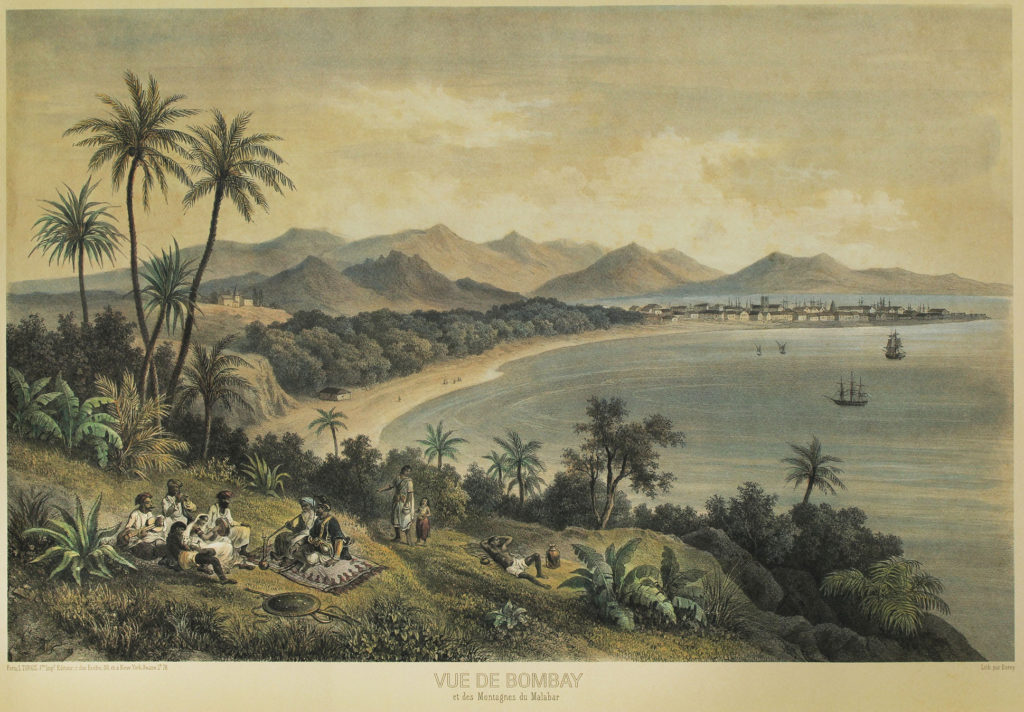
Vue De Bombay et des Montagnes du Malabar [View of Bombay and Malabar Mountains], coloured lithograph by L.Turgis, c.1850 © Sarmaya Arts Foundation
For an intrepid tourist with a head full of dreams, Mumbai’s Marine Drive is the backdrop for most life-altering decisions. Move or stay, love or leave, go big or go home. It’s where achievement and aspiration live side by side in old Art Deco homes, plush five-star hotels and branded high-rises, all putting their best face forward to create the perfect, most Instagrammable skyline. “A poor little island”, then, doesn’t seem quite the description befitting the city you see today. It’s how British Member of Parliament Samuel Pepys famously referred to this archipelago of islands when the East India Company acquired it from the Portuguese for an annual fee of 10 pounds in 1668. The poor little island, however, would turn out to be a gold mine for the Company.
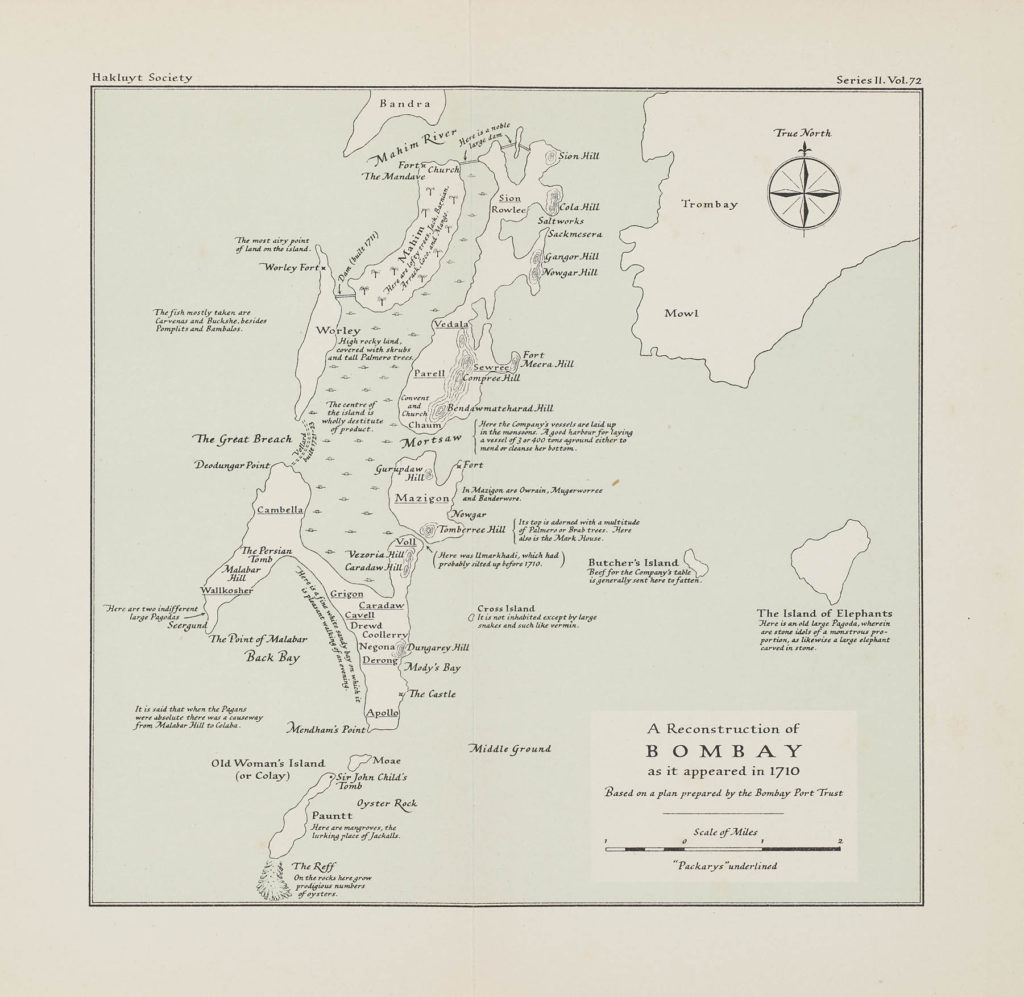
Map of Bombay, from ‘Bombay in the days of Queen Anne, Being an Account of the Settlement’ by John Burnell, originally dated 1710 © Sarmaya Arts Foundation
Much of Bombay’s cultural, political and economic metamorphosis to a power centre under British imperialism had to do with aspirations, both individual and collective. The aspirations of the colonisers as well as the merchants, traders and migrants who came to find work here. And over the better part of the late 19th-century, the city began to steadily transform from a mere trading town to a fledgling industrial and manufacturing hub. The poor little island became a true Presidency Capital for the British, who exploited the city’s abundant resources to fatten up their coffers. The establishment of an overland route to London in 1838 sped up movement of goods and people. But Bombay would witness its most prosperous times in 1861. The American Civil War put a stop to the trans-Atlantic supply of cotton to Britain. Bombay picked up the slack and saw a boom in cotton trade that lasted a long time. Such was the demand for cotton that people were ripping open their old mattresses to sell the filling for a neat profit.

‘Cotton Market, Bombay’ by Edward Sache c.1860s © Sarmaya Arts Foundation
In his enthralling book, City Adrift: A Short Biography of Bombay, author Naresh Fernandes reflects on this cash-rich period, which was marked by a steady increase in the price of food, rents and wages. Migrants from the coast, the United Provinces in the north and other regions of the subcontinent poured in to work at Bombay’s factories. And prosperous times meant significant changes in geography too. The islands that constituted the city were united through land reclamation to make room for its growing population. A diverse citizenry, indigenous capital investment, and the opening of the Suez Canal linking its port to Europe in 1869 consolidated Bombay’s status as an emerging economic power on the world stage.
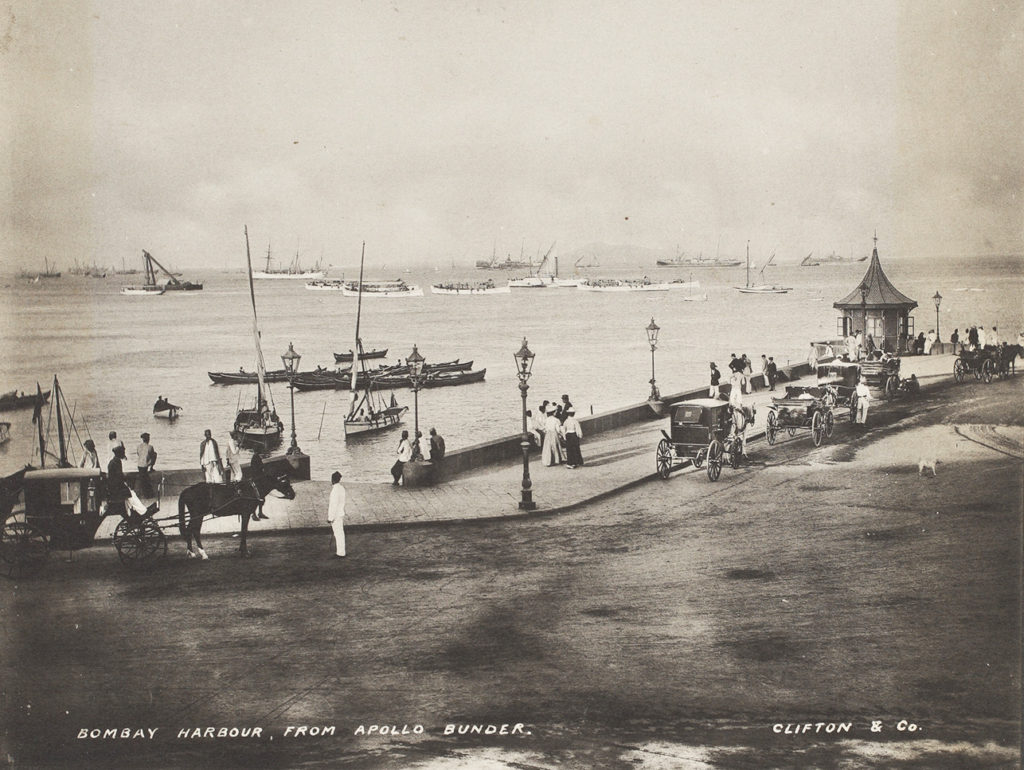
Bombay Harbour from Apollo Bunder by Clifton & Co, c.1900 © Sarmaya Arts Foundation
A plaque outside the Gateway of India takes you back to this glorious time in history. Urbs Prima in Indis, it reads. The First City of India. At the first major all-India census of 1872, with a population of 644,405, Bombay emerged as the largest city in the Indian subcontinent and the second-largest in the British empire, after London. “By the early 1892, the city would have sixty-eight mills, employing 65,087 workers… The mill workers would form a potent social and political force that would influence Bombay life for just under a century…,” writes Fernandes in his book.
Like a puzzle coming together to recreate a familiar vision, Bombay’s heterogeneous population began to create an eternal city of dreams here. An industrious community that had made Bombay home in the mid-1600s and earned a reputation for their trading skills was coming into the spotlight. A man named Dorabji Nanabhoy, the first-ever Zoroastrian to set foot here around 1640, was employed by the Portuguese to transact with the local population and later, by the British, to collect taxes. To the British, the Zoroastrians were different from the rest of the minorities flocking to Bombay and a means to further the industrial expansion in India. To the Zoroastrians, British Bombay’s promise of freedom of religion and of equality before the law—neither of which were assured under either Muslim or Portuguese rule at the time—made the island an attractive prospect and ideal for a Parsi influx. Two centuries later, in 1854, the first steam cotton mill would be founded by a Parsi named Cowasji Nanabhai Davar. By 1870, Parsis would own nine of Bombay’s 13 mills.
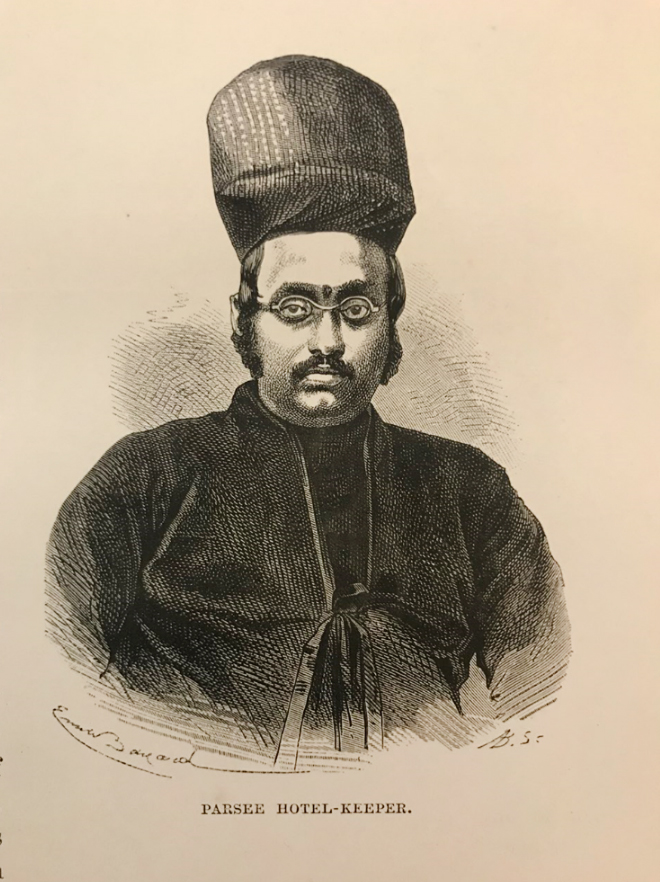
‘A Parsee Hotel-Keeper’, illustration from ‘India and its Native Princes’ (1876) by Louis Rousselet © Sarmaya Arts Foundation
While trade flourished, the Presidency explored new cultural dimensions too. When it came to the urban architecture of Bombay, the British continued in the grand style of Indian monarchy with domes, chattris, chajjas and arches proclaiming an Indo-Saracenic style. The intention was to suggest a shift in the notion of the Empire. Mustansir Dalvi, author and professor at the Sir JJ College of Architecture, explains, “Buildings across the city were ordered to adopt London’s neo-Gothic style but lose elements of Christianity at the same time. These buildings were meant to be reminders of a secular Bombay, of authority under the most legitimate rulers,” says. “Architecture that’s classically correct, symmetrical, and built on an axis was combined Islamic features like domes, for which the British had great awe and admiration.” Most civic buildings like the General Post Office (built in 1905) or the Prince of Wales Museum (1905-’14) in Bombay stand testimony to this philosophy.
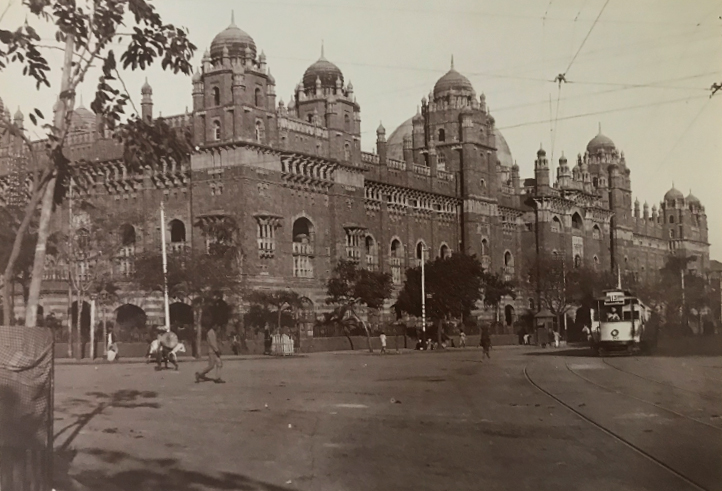
General Post Office, unidentified photographer, 1921 © Sarmaya Arts Foundation
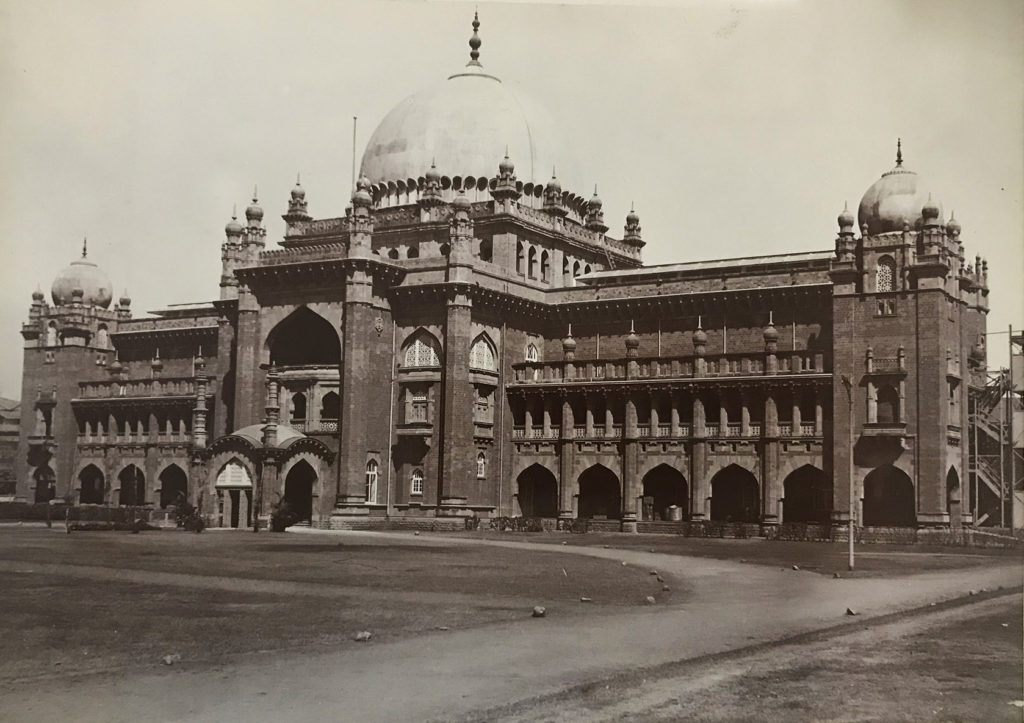
The Prince of Wales Museum, unidentified Photographer, 1921 © Sarmaya Arts Foundation
Like in the visual arts, where British academics, artists and cultural administrators worked to develop a syncretic pictorial agenda in the second half of the 19th century, architecture in India too demonstrated the same process of co-production between Indian and European contributors. Renowned poet, cultural theorist and curator Ranjit Hoskote explains, “This is evident in the art schools that emerged in various Indian centres from the 1850s onward. For instance, in the Calcutta School of Industrial Art (1854), there was a strong emphasis on miniatures. At the Mayo School of Industrial Arts (1875) in Lahore under John Lockwood Kipling – who went there from Bombay – Gandhara work became a massive focus. The museum collected Gandhara Buddhist artefacts and there was an emphasis on responding to this historical material, to calligraphy, and to Mughal art.”
The prime taste-maker in the arts in Bombay was, of course, the Sir Jamsetjee Jejeebhoy School of Art founded in March 1857. Hoskote puts this in perspective when he talks about the absurdity in the theory that the British ‘usurped Indian art’: “In the first phase of its existence, [the JJ School of Art] was modelled on the Kensington curriculum, with an emphasis on the decorative arts. In the second phase, under the direction of Gladstone Solomon, it underwent a transformation towards the Royal Academy model, with life classes and live models introduced for the first time. Throughout, it emphasised a particular Orientalism founded on the empathetic embrace of classical Indian art. The annual trip to Ajanta and the copying of Ajanta murals by students was a cornerstone of the JJ pedagogy. Take the work of Principal Claude Batley of the Sir JJ College of Architecture, and you will see his strong sense of engagement with his Indian environment.” He also helpfully points out how the archives of the College relating to the late-19th and early-20th centuries, demonstrate its commitment to documenting the ‘wadas’ of the Maratha-Peshwa aristocracy, as well as Rajput and Adilshahi architecture.
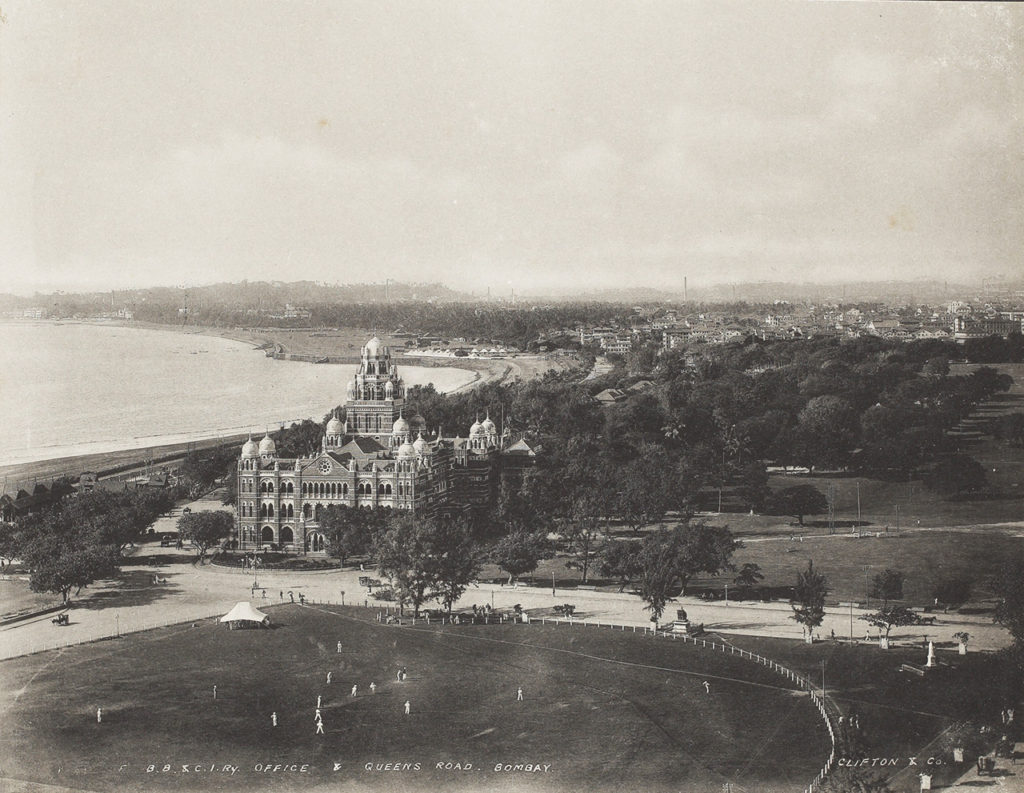
BBCI Railway Office Bombay by Clifton & Co., c.1890s-1930s
If art witnessed imperialists going back to India’s rich past for inspiration, politics saw the birth of a polarised narrative when the nation began to write its own history as a reaction to its subjugation. Through the latter half of the 1800s, its thriving economy pushed Bombay into a new chapter where art, culture, theatre, and indigenous music flourished with a vengeance.
A young Bombay, armed with western education, rallied for literary and scientific societies. Newspapers in regional languages such as Gujarati, Marathi, and Urdu gained fierce loyalists. In 1847, a group of young mechanics established a museum and library for architectural design that the Jewish cotton- and opium-tycoon David Sassoon would endow with a new home in Kala Ghoda 16 years later. What we know as the JN Petit Library today was the initiative of 12 Parsi students from Elphinstone College who wanted a reading room and formed one on Modi Street in 1856. Thirteen institutions of higher learning (arts and professional colleges) and 481 (high and middle) secondary schools made Bombay the premiere centre of education in western India by 1900. Education was benefitting from the growth of private high schools as much as it did from the Presidency’s leading Elphinstone High School and institutions like St. Xavier’s College, founded in 1869 by the city’s Jesuits. And even as education empowered Indians, music and theatre made a much-welcomed entrance in the 1850s. A prime example is what you call the Hindustani music today.
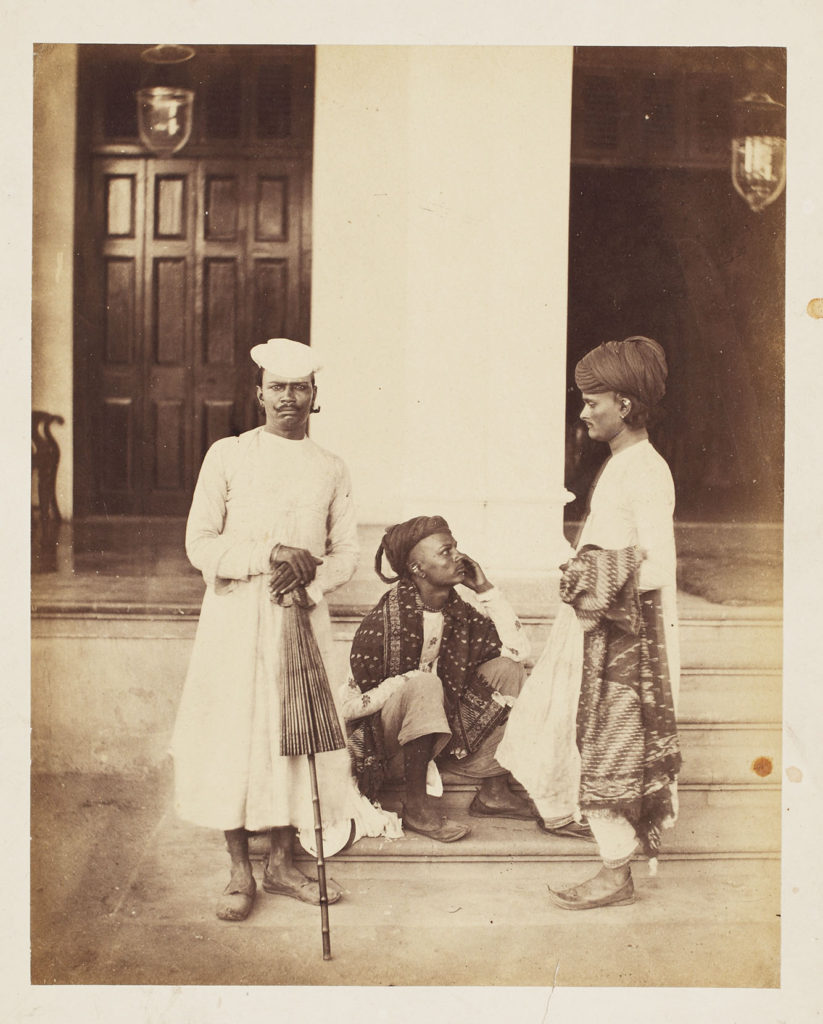
‘Marwaree Brokers’ by William Johnson from ‘Photographs of Western India. Volume I. Costumes and Characters’, 1855-62 © Sarmaya Arts Foundation
After 1857, the decline of the Mughal court in Delhi saw a rise of the mercantile bourgeois and middle classes. This brought about the migration of Hindustani musicians from acclaimed gharanas to Bombay as well as to small princely states of Maharashtra. In 1870, three brothers – Chaju, Nazir, and Khadim Hussain Khan – who’d spent decades studying the greatest Ustads in India decided to settle in Bhendi Bazaar. Soon after, the brothers from Bijnaur became much sought-after performers, and gave Bombay its very own classical music tradition, the Bhendi Bazaar gharana. Several other renowned musicians began to influence colonial Bombay with their shift in patronage. Kirana gharana’s Abdul Karim Khan moved to Saharanpur, Alladiya Khan to Kolhapur, and Vilayat Husain Khan from Agra gharana arrived in Bombay too. Then came the Parsi theatre, the Marathi sangeet natak, the wealthy patron’s baithak, the concert stage in areas like Laxmi Baug, Brahman Sabha or Jinnah Hall in Girgaum. The achievements of this culturally diverse population held out a shining promise that hasn’t dimmed over the years: In Bombay, no dream is too big to dream.
It’s what prepared the grounds for the film industry to take root. A 40-minute silent, black-and-white inter-titled film (in English, Marathi and Hindi) heralded the era of film production in Bombay towards the beginning of the 20th century. Dadasaheb Phalke’s feature film, Raja Harishchandra, sowed the seeds for this ambitious enterprise that would give the city its most phenomenally distinctive community. Soon after the film was shown in 1913 at Coronation Cinema, many aspiring filmmakers started trickling in to found studios and production companies in Bombay. The film industry established its position as a powerful match to Bombay’s textile industry with a rise in the number of theatres, studios, and labs by the early 1930s. And even though Phalke the ‘Father of Indian Cinema’ would die penniless in 1944–after several failed attempts to keep his studio running–he had lit the flame that would bring the beloved studio, Bombay Talkies, into existence in 1934. Several producers of the Presidency era, including Sohrab Modi, Himanshu Rai, V Shantaram, Shashadhar Mukherjee and Ardeshir Irani, came to be visionaries of Indian cinema. Their early faith in the medium laid the foundation for the glittering Mumbai of today.

‘The Town-Hall, in the Fort’ (today’s Asiatic Society of India), illustration from ‘India and its Native Princes’ (1876) by Louis Rousselet © Sarmaya Arts Foundation
Bombay was culturally alive with a steady undercurrent of ‘mutiny’ making its presence felt even before MK Gandhi’s arrival here in 1888. The city’s political importance grew as a staging post for traders, workers, and the Company’s officials on the international route. It may be recalled that the Presidency’s first political organisation, Bombay Association, was founded by a Parsi reformer in 1852. Its sole purpose was to take public grievances to the British. The Bombay Presidency Association and the Indian National Congress (INC) came much later in 1885 – setting the stage for India’s independence movement. It was Bombay that became the testing ground of many of Gandhi’s ideas: Satyagraha, non-cooperation and the Swadeshi movement. When Gandhi embarked upon his first nationwide protest, Satyagraha against the Rowlatt Act in 1919, the people of Bombay responded with unflinching support. The city also served as the site for the launch of the non-cooperation movement in 1920. The following year, in Elphinstone Mill compound, Bombay boycotted foreign cloth by throwing them into bonfires. This event also truly marked women’s entry into politics and public life. Gandhi reciprocated with a meeting at Chowpatty where he addressed his massive following: “Bombay the beautiful lit yesterday a fire, which must remain ever alive.” The fire would spread indeed and galvanise India for its freedom struggle.
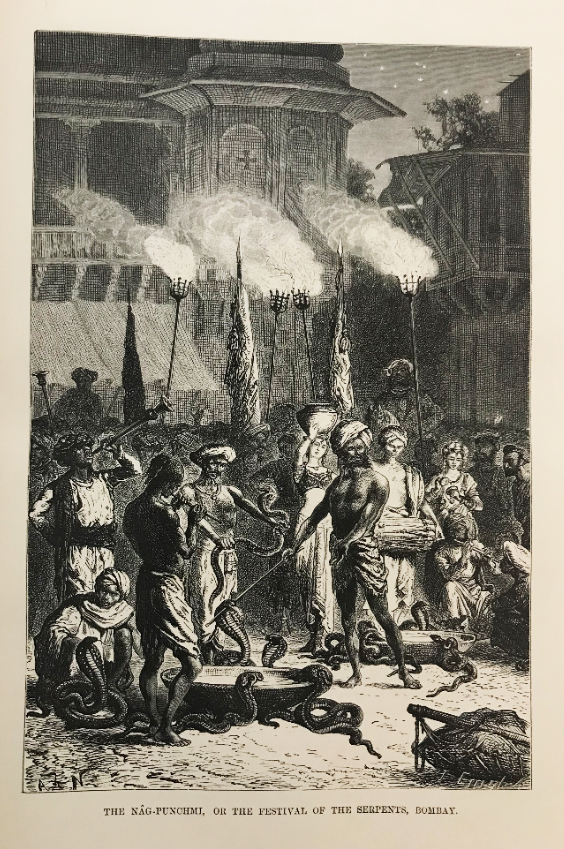
‘The Nag Panchami festival’, illustration from ‘India and its Native Princes’ (1876) by Louis Rousselet © Sarmaya Arts Foundation
Remarkably, though, nationalistic upheavals and changes to the spatial and cultural fabric of 19th-century Bombay didn’t dull the spirit of its motley crew of dreamers and doers. Fernandes puts it beautifully when he observes, “Bombay’s greatest pleasures in the nineteenth century were taken in public.” It was a city that turned no one away, with its migrants playing their evening games of cards, its vendors selling sugarcane, its skilled acrobats, storytellers and snake charmers taking over its busy streets under the midday sun. The Bombay of glorious lores will, perhaps, always be this Bombay of the 19th century – a tableau vivant in sepia tones. Two centuries later, the poor little island continues to generously welcome intrepid travellers who hope someday to belong.
References
- City of Gold: The Biography of Bombay by Gillian Tindall
- City Adrift: A Short Biography of Bombay by Naresh Fernandes
- The Making of the Middle Class: Toward a Transnational History by A Ricardo Lopez, Barbara Weinstein
- Architecture in India: The last 200 Years by Mustansir Dalvi
- Versions of a Postcolonial Metropolis: Competing Discourses in the Formation of the Image of Bombay since the 1990s by Ranjit Hoskote
- Commerce, Conquest and the Colonial City: Role of Locational Factors in Rise of Bombay by Meera Kosambi
- Bollywood: A Guidebook to Popular Hindi Cinema by Tejaswini Ganti



